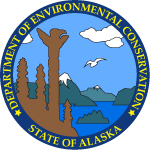| Action Date |
Action |
Description |
DEC Staff |
| 1/18/1995 |
Site Added to Database |
File number 400.38.008. |
Steve Bainbridge |
| 7/1/1995 |
Update or Other Action |
(Old R:Base Action Code = RAU - Remedial Actions Underway (General)). FSS tanks HOT 11-D-2 and UST 11-D-1 had caused soil and groundwater contamination. A release investigation report dated 3/18/1996 (HLA) provided test data from monitoring wells and soil borings. |
Dick Farnell |
| 9/19/1995 |
Update or Other Action |
Insufficient data to generate score. Staff to contact RP for more information. |
Mehrdad Nadem |
| 6/24/1997 |
Update or Other Action |
Date of analytical results for soils from FAA's Nome Station that were thermally treated. Results were submitted with an FAA cover letter dated September 22 1997. |
Eileen Olson |
| 9/5/1997 |
Update or Other Action |
Letter from consultant to FAA explaining remedial process and transmitting results for post- remediation sampling of approximately 465 cubic yards of 2-inch-minus material. |
Eileen Olson |
| 9/18/1997 |
Update or Other Action |
Letter from EPA Region 10 noting that the FAA Nome Station was evaluated and found not to score high enough to be proposed for inclusion on the NPL. |
Eileen Olson |
| 11/22/1997 |
Update or Other Action |
Letter from FAA requesting site closure status for tank sites related to accompanying post-thermal remediation results dated 6/24/1997. |
Eileen Olson |
| 10/27/1998 |
Update or Other Action |
Spill report for gasoline and diesel releases encountered during 1995 UST closures at the FSS. |
Dick Farnell |
| 1/25/2000 |
Site Ranked Using the AHRM |
Initial Ranking. |
Eileen Olson |
| 6/9/2000 |
Update or Other Action |
In a letter of this date, ADEC granted site closure for three unregulated tank sites and two regulated tank sites. Of the unregulated tanks, two were at the Sewage Treatment Plant and one was at the VORTAC. The letter noted that contamination at the FSS related to tanks 11-D-1 and 11-D-2 will still need to be addressed as per Farnell's 3/6/1997 letter. |
Dick Farnell |
| 12/28/2000 |
Update or Other Action |
ADEC received a cover letter dated 12/26/2000 with an attached submittal, the February 1999 Intrinsic Remediation Evaluation for the FAA Nome Flight Service Station. Based on the evaluation, FAA proposed continuing monitoring of groundwater until DRO levels in groundwater attenuate to below ADEC's criterion of 1.5 mg/L. |
Eileen Olson |
| 9/4/2003 |
Update or Other Action |
ADEC approved the workplan for the Fall 2003 Sampling and Analysis Plan for various sites. |
Deborah Williams |
| 11/1/2005 |
Update or Other Action |
Backdated entry, entered into database on 7/25/2023: The final September-October 2004 GW monitoring report noted the following: Fuel-like odors at MW-1, MW-3, and MW-10; Sheen in MW-3; a thin layer of free product (0.02 ft) in MW-10. DRO exceedances were detected in MW-3 (1800 µg/L), MW-10 (5100 µg/L), and MW-11 (1,500 µg/L). |
Jamie McKellar |
| 3/8/2006 |
Update or Other Action |
Site review at request of FAA manager, David Jadhon. Complete site looks fine, multiple UST's closed. Flight Service Station facility has a few cubic yards of contamination not accessible under foundation. Plume also exists in area of Flight Service station, but is small and appears to be stable. FAA submitted 4-phase model showing minimal risk to human health and environment from plume. Current site info would lead to this conclusion; however, 4-phase model may not be needed. Letter with steps to closure being crafted. |
Mike Jaynes |
| 8/17/2009 |
Site Characterization Workplan Approved |
Commented on draft site investigation work plan for Shop Building 200, Flight Service Station (FSS), Outer Marker, Localizer, and RCAG facilities at the FAA Nome Station. Proposed work includes sampling floor drains at the shop building and soil sampling for PCBs at current and former transformer locations. Additional work includes investigation at a former UST location at the VORTAC facility and groundwater sampling at the FSS. |
Melody Debenham |
| 12/8/2010 |
Site Characterization Report Approved |
Approved the site investigation summary report for the Shop Building 200, Flight Service Station (FSS), Outer Marker, Localizer, VORTAC, and RCAG facilities. Samples from two floor drains in Shop Building 200 had diesel range organics (DRO), arsenic, and chromium above cleanup levels. Groundwater sampling at the FSS had DRO above the cleanup level in two wells. Soil samples collected at the localizer, outer marker, VORTAC, and RCAG facilities for PCBs were all non-detect. |
Melody Debenham |
| 12/8/2010 |
Conceptual Site Model Submitted |
Conceptual Site Model submitted as part of Site Investigation Summary Report. |
Melody Debenham |
| 12/8/2010 |
Update or Other Action |
Backdated entry, entered into database on 7/25/2023: The Final Site Investigation Summary Report for FAA Shop Building 200, Flight Service Station, Outer Marker, Localizer, VORTAC, and RCAG Facilities indicate that at the former FAA Shop Building 200, DRO, arsenic, and chromium were detected above the applicable cleanup levels. In the associated work plan, DEC requested that FAA sample the discharge for a drainage pipe; however, this activity could not be completed because the pipe had been filled in and was beneath a roadway. The report recommended a background study for arsenic and collecting additional samples with a drill rig. At the former FSS, DRO was detected in MW-2 and MW-10 with concentrations of 3,390 and 4,640 µg/l, respectively. Free phase product was observed on tubing that was used to sample MW-3.
Note: Building 200 is also referred to as Building 302. Boiler House Building 3030 is to the immediate east of Building 200/302. |
Jamie McKellar |
| 9/18/2012 |
Document, Report, or Work plan Review - other |
Approved the final injection well closure report documenting the permanent closure of two floor drains at Building 302, the north drain and the south drain. The north drain was connected to a discharge pipe ending 50 feet west of the building. The discharge pipe was plugged and the drain filled with clean material and capped with concrete. Results from a soil sample collected beneath the outfall pipe showed arsenic above the cleanup level. The south drain was a sump drain with an open bottom. The sump was filled with clean material and capped with concrete. Results from a sample collected beneath the sump floor show diesel range organics, arsenic, and chromium above the cleanup level. |
Melody Debenham |
| 11/19/2012 |
Update or Other Action |
Received letter from the EPA Underground Injection Control (UIC) program documenting that the floor drains at Building 302 are now listed as permanently closed in the UIC program file, with the condition that contamination remaining under the building will be addressed when the building is decommissioned. |
Melody Debenham |
| 1/1/2015 |
Update or Other Action |
Backdated entry, entered into database on 7/25/2023: The Final Environmental Remediation Report indicates that MW-3 was decommissioned because excavation of the 10,000-gallon water tank resulted in destruction to the filter pack. MW-3 was historically one of the more contaminated wells at FAA Nome Station. During previous mobilizations, sheen was observed in MW-3 and free product was observed on the tubing that was used to sample the well. It does appear that a replacement well for MW-3 was installed. |
Jamie McKellar |
| 2/25/2015 |
Document, Report, or Work plan Review - other |
Approved final Flight Service Station decommissioning report. Confirmation sample results at the former transformer pad are below the cleanup level for PCBs. Confirmation sample results at the UST 11-D-101 location are below the cleanup levels. Sample results from the former UST 11-D-1 and 11-D-2 location show petroleum contamination remains in place. Groundwater monitoring results show DRO above the cleanup level in 3 wells. Recommendations include additional site characterization to delineate the extent of remaining soil contamination and continued groundwater monitoring. |
Melody Debenham |
| 5/3/2016 |
Update or Other Action |
Sent request to FAA for anticipated schedule of additional work. |
Melody Debenham |
| 6/29/2018 |
Update or Other Action |
CLEANUP COMPLETE REQUEST received from FAA for Flight Service Station (FSS) Building Contaminated Soil, Localizer (LOC) PCB in Soil, and Outer Marker (OM) Oil-Filled Transformer. Dated June 29, 2018. |
Jamie McKellar |
| 8/2/2018 |
Update or Other Action |
DEC Responded to FAA’s request for closure that the FAA Nome Station FSS Building. Closure requests for the other two source areas (Localizer (LOC) PCB in Soil, and Outer Marker (OM) Oil-Filled Transformer) will be addressed under separate cover. Based on DEC’s review, the FSS Building is not eligible for a cleanup complete determination for the following reasons: 1) PCB contamination at the FSS Building has not been fully delineated. No samples have been collected from beneath the concrete pad, where previous reports indicated that PCB concentrations are suspected to be highest. Additionally, the 2010 exceedance was located at the northeast corner of the pad; subsequent sampling did not chase contamination in this area. 2) Petroleum contamination at the FSS Building has not been fully delineated. The 2014 Environmental Remediation Report for the FSS Building noted that additional site investigation is required to determine the full extent of the soil contamination associated with former USTs 11-D-1 and 11-D-2. Groundwater monitoring was also recommended at the FSS since contamination was believed to be related to the groundwater smear zone.
|
Jamie McKellar |
| 8/7/2018 |
Update or Other Action |
DEC responded to FAA's request for closure of the Localizer source area. The Localizer has not been fully characterized and is not eligible for a Cleanup Complete determination. Samples have not been collected on the east side of the original pad (now covered by concrete), on the west side, or underneath the concrete pad. As such, the transformer pad at the Localizer requires additional characterization. |
Jamie McKellar |
| 11/6/2018 |
Update or Other Action |
DEC received information from FAA indicating that the OM pole-mounted transformer is still in place and anticipated to be removed in summer 2019; the localizer is still active (as such, PCB contamination cannot be delineated until such time that the localizer is decommissioned); and the FSS transformer pad has been removed. DEC has not previously been informed of the transformer pad removal. Based on previously provided information, additional sampling will be required both under the former pad and in the northeast corner. |
Jamie McKellar |
| 4/30/2019 |
Meeting or Teleconference Held |
Contacted FAA for an update on 2019 field work in Nome. FAA stated that the work in Nome will be going out to bid soon. There are currently no dates for the Nome project; however, it may be phased in between this fall, winter, and possibly next summer. FAA will keep DEC updated as the project takes shape. |
Jamie McKellar |
| 3/16/2020 |
Document, Report, or Work plan Review - other |
REPORT APPROVAL: Final Demolition, Remedial Action, and Release Investigation Work Plan, Various Areas of Concern at FAA Nome (Brice, September 2019) |
Jamie McKellar |
| 7/27/2022 |
Site Characterization Report Approved |
On July 27, 2022, DEC approved the Final Demolition, Remedial Action and Release Investigation Report, Various Areas of Concern, former FAA Nome Station, Nome Alaska (Brice Environmental, July 2022). Remaining soil contamination includes DRO, ethylbenzene, naphthalene, 1,2,4-Trimethylbenzene, and 1,3,5-Trimethylbenzene. Groundwater contamination includes DRO and RRO. To date, the horizontal and vertical extent of contamination in soil and groundwater has not been adequately delineated at the FSS. |
Jamie McKellar |
| 8/28/2024 |
Update or Other Action |
DEC reviewed the available information for the Outer Marker Transformer site. The transformer was labeled to contain polychlorinated biphenyls (PCBs). Two surface soil samples were collected and analyzed for PCBs in 2010, and the analytical results were all non-detect. In 2020 the transformer structure was removed from the site. Based on the available data there is no indication that a release occurred, and no further action is required at the Outer Marker Transformer. |
Sophia Bracio-Martinez |




